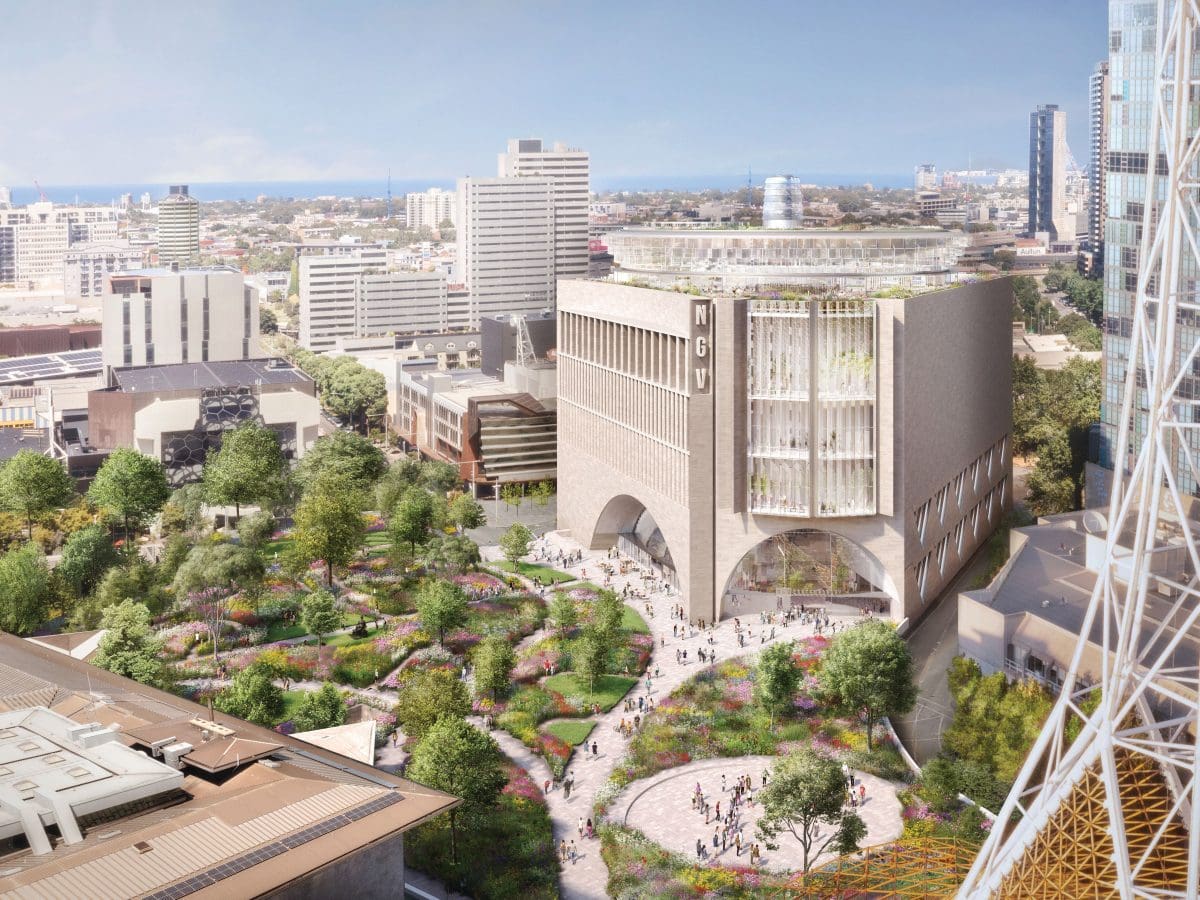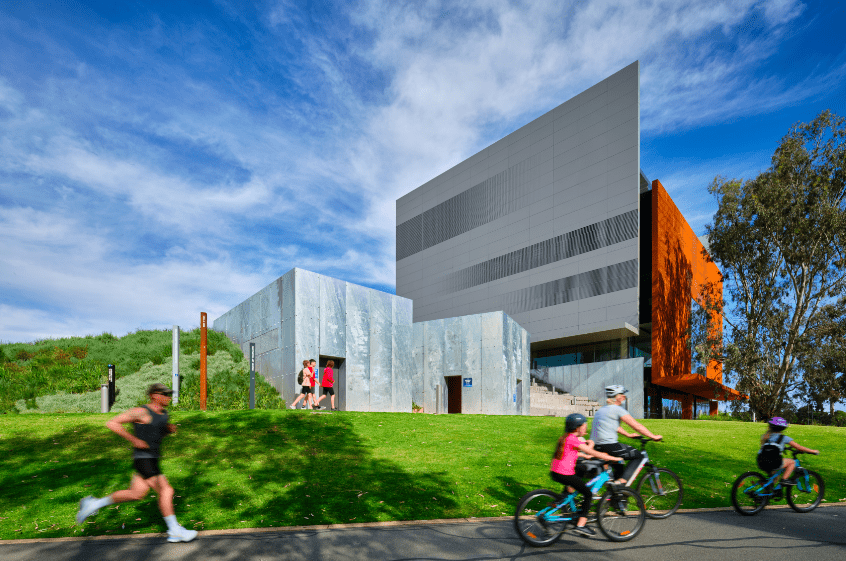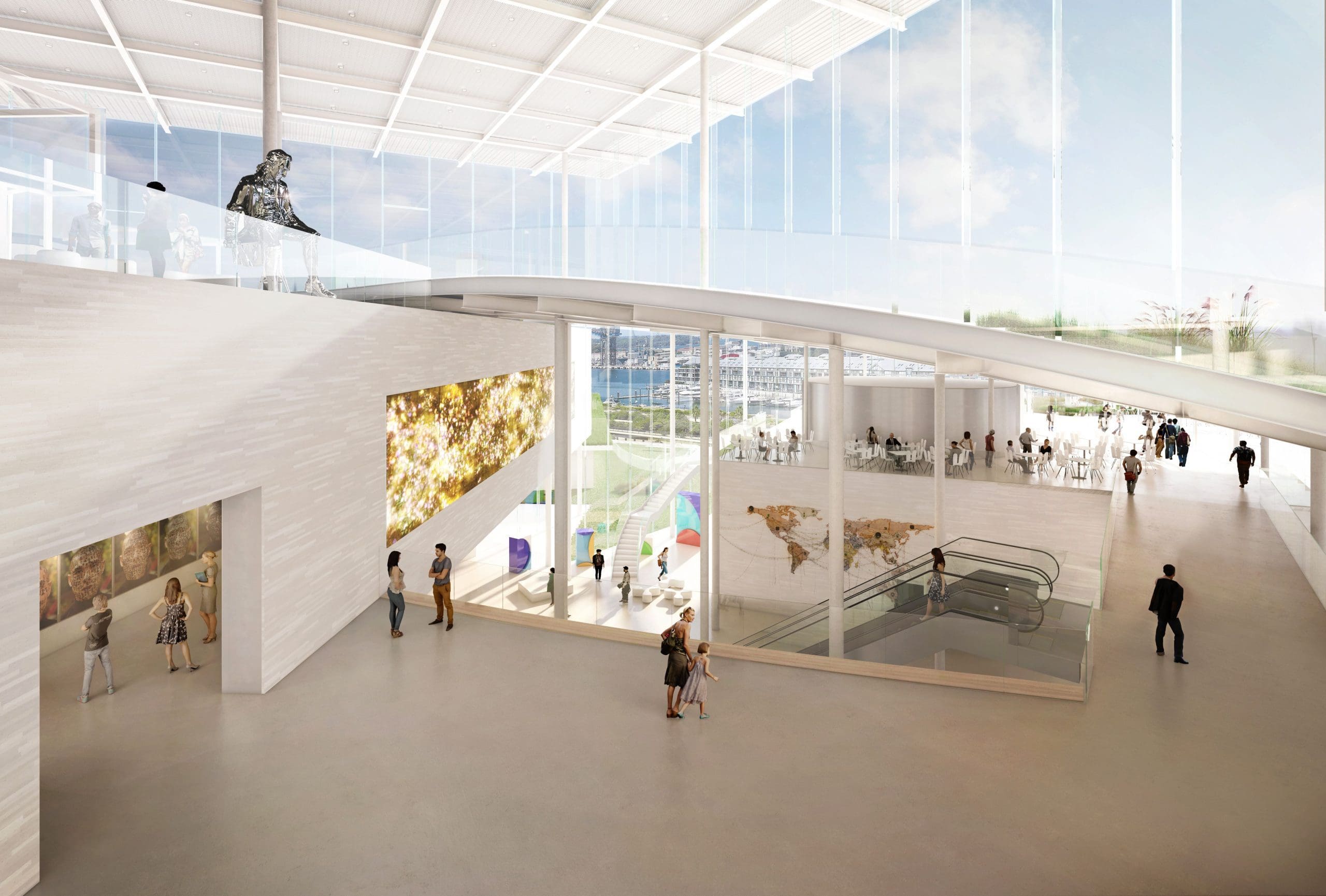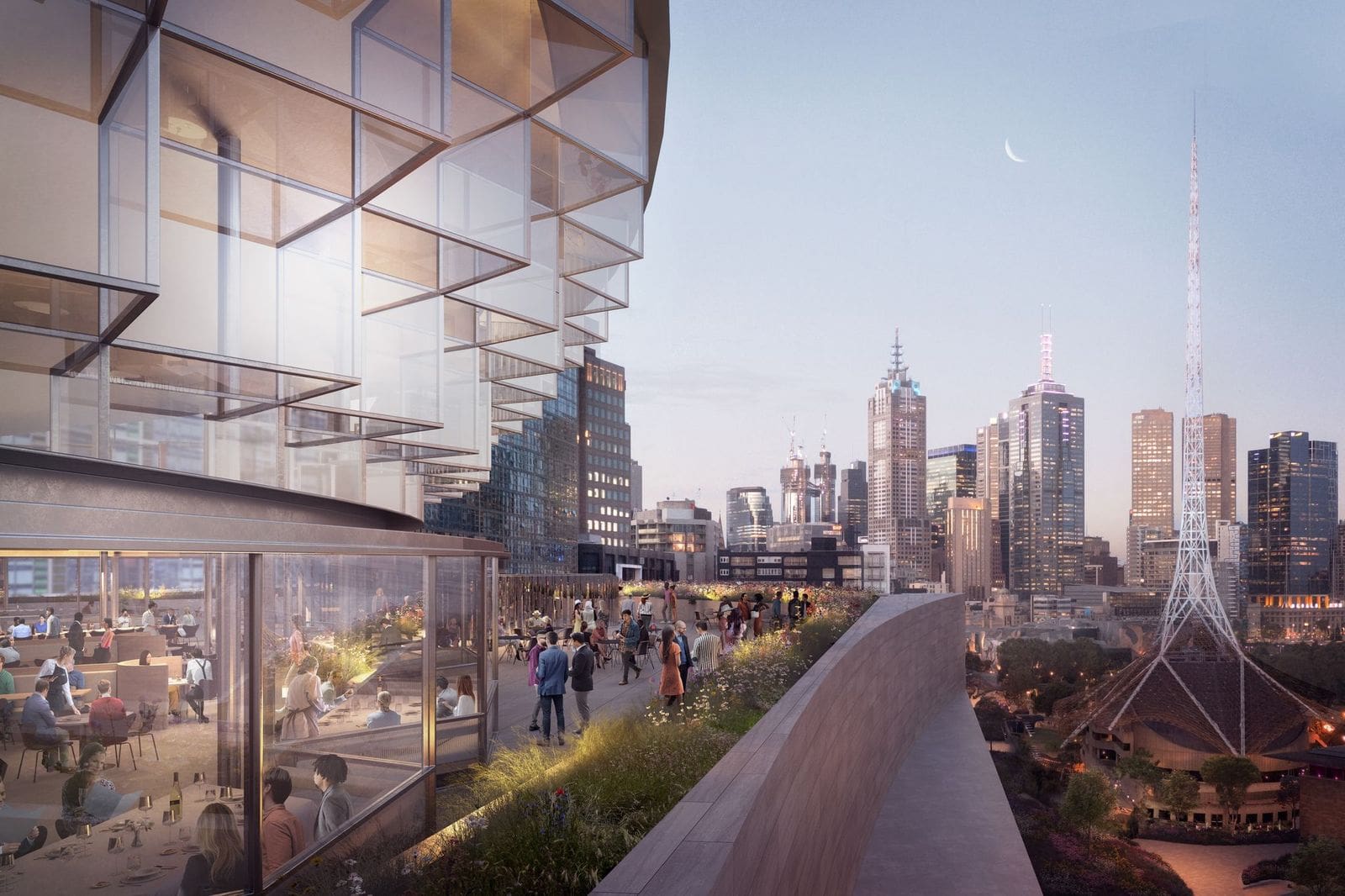
Poetics of Relation
Tender Comrade, currently on show at Sydney’s White Rabbit Gallery, creates a new vocabulary of queer kinship by reimagining the relationship between artworks, bodies and space.



When the first sod of earth is turned sometime this year to begin work on the new National Gallery of Victoria building, The Fox: NGV Contemporary, the focus will be on the future—namely, the building’s certain glory as the centrepiece of the new $1.7 billion Melbourne Arts Precinct revamp around Southbank.
The distinctive design of the new building is marvellously upbeat: bright, airy and welcoming, it boasts breathtaking archways, rooftop gardens with views, and a 40-metre-high spherical entrance hall that is vibrant with potential, its galleries spiralling upwards.
By the time it opens with fanfare in 2028, few will recall the NGV wasn’t the only art institution embarking on a bold venture back in 2022: art galleries around the nation seem to be amid an extraordinary building boom. It’s an upsurge of optimistic construction and renovation that runs counter to the persistently depressing narrative of closures and struggle that has been coming out of the funds strapped arts sector since Covid-19 hit Australia in early 2020.
Many arts industry watchers might well ask why this construction boom is happening now, and what it all signifies. They might wonder if it is more evidence of “theme park” culture privileging sparkly venues and blockbuster entertainment over small organisations and cash-strapped working artists—or if it’s simply the arrival of long-awaited investment, from various government and private sources, giving major art venues the expansions and upgrades they need and deserve.
Certainly, a lot of money is being spent.
For NGV Contemporary, the Fox family (of Linfox logistics company fame) has contributed $100m, and the Ian Potter Foundation $20m. More than $344m is being spent on the Sydney Modern Project, announced in 2011, which includes a grand new light-filled building opening in December alongside its parent, the redeveloped Art Gallery of New South Wales. In Melbourne, the $40m ACMI redevelopment was long awaited and finished last year—a year that also saw the opening of the Gold Coast’s $60.5m Home of the Arts (HOTA), and of the redevelopment of the Art Gallery of Western Australia (AGWA).
While the $200m Aboriginal Art and Cultures Centre in Adelaide is not set to open until 2025, 4A Centre for Contemporary Asian Art in Sydney’s Haymarket has reopened following a recent multimillion-dollar renovation. Also soon reopening is the new Artspace, completing renovations of its Gunnery building in Woolloomooloo.

In the regions, there is a lot of action, too. Shepparton Art Museum (SAM) has become the city’s long-awaited $50m cultural gem, opening last year, while the Rockhampton Museum of Art reopened in February after a complete makeover, expanding its site with massive new spaces to make it a Queensland destination thanks to a federal, state and local government funding partnership totalling $33m.
Further south, the Newcastle Art Gallery has just embarked on a $36.5m redevelopment while Bundanon, at Shoalhaven on the south coast of New South Wales, opened its new $34m Art Museum and Bridge for Creative Learning in January. And Castlemaine Art Museum recently received $6m for an upgrade, with an emphasis on accessibility through its art deco frontage.
This all amounts to over $1 billion of investment in just a few years.
Among the commercial galleries and artist-run spaces there’s also been plenty of activity, despite the dire Covid-impact reports. New spaces include Milk, Void, 1301SW and 99% Gallery in Melbourne. Meanwhile in Sydney there’s Sketch Collective Gallery, Max Patte + Lightworx Gallery, HAKE House of Art, and Culture Vault.
NAP Contemporary is a new Mildura gallery and Wester Gallery in Newcastle is opening in July. Add to these a number of broader arts ventures, such as the Walsh Bay wharf development in Sydney, a new arts precinct in Melbourne’s inner-suburb Richmond, and the STH BNK development in Melbourne—this last one is an extraordinary collaboration between the Centre Pompidou in Paris and property developer Beulah for a new 3000-square-metre contemporary arts space.
Penelope Benton, the executive director of the National Association for the Visual Arts (NAVA) says this boom in construction and investment in the arts is certainly something to be celebrated, and she welcomes the investment and expanded ability to draw in new, larger audiences.
However, she has concerns about the lack of overarching strategy and vision across the sector. “We’d like to see Australia have a strong national arts infrastructure of public and private presenting organisations investing in the people and the work that will fill these new spaces,” Benton says. She envisions investment aimed at creating a healthy and interconnected arts ecology, which she says “is what has been missing for too long” in Australia. “We need cultural infrastructure investment to be matched or exceeded by cultural programming investment.”
Benton knows that many galleries—especially ageing regional sites—have been struggling to maintain their existing buildings, add to their art collections, tour work, present public programs and, importantly, pay artists fairly. “So many [artists] have fallen through the cracks with the pandemic and extreme weather events,” she says. “So many galleries and artists are in a great deal of financial strain and a lot more needs to be done.”

NAVA surveys undertaken since the onset of the pandemic have shown that a majority of visual artists and arts workers remain deeply concerned by income security. One survey showed many were hit by a double whammy: losing their university jobs and also suffering show cancellations related to their arts practice. Along with visual art organisation closures, artists also reported significant reductions in both their output and their confidence, she says.
Benton praises the Australia Council for the Arts for the way it has, over 40 years, ensured that funding is spread and invested in a careful mix of both presenting art and supporting organisations that have an impact at all stages of artists’ careers, and across regional and urban areas. Yet she has been very frustrated in recent years by the former Morrison government not having any long-term vision built into its allocation of arts funding, with large amounts of pandemic-relief money being directed at large, short-term entertainment events that created a quick burst of success. “Without the strategic oversight, that money is a lost opportunity to invest in the ecology.”
At the AGNSW, director Michael Brand expresses a strong interest in fostering that ecology. He says great cultural developments such as the Sydney Modern Project enhance the global perceptions of cities, states and nations. “They express the identity, history and creativity of a place,” he says. “Our positioning as a gateway to New South Wales is evidenced in the meaningful relationships we have with regional communities, art galleries and other cultural institutions. We celebrate the cultural and linguistic diversity of Sydney through our exchange with communities with rich histories and lived experiences.”
Brand says the expanded AGNSW campus will extend its appeal to diverse local, national and international audiences not just through engagement with works of art, but also through digital capabilities, specialist resources, programs and events. “This is a rightly ambitious project for a global city such as Sydney and a new public asset that will deliver cultural and economic benefits beyond the city for generations to come. In the broadest sense, an iconic project like this elevates the prominence of visual arts in our society. It will provide more art to more people and more opportunity to artists—to work in exciting new ways and with greater international recognition.”
At the NGV, the new building designed by Angelo Candalepas and a team of architecture and engineering firms, is going to be Australia’s largest contemporary art and design space, and it even has sports stadium-style branding to reflect its stature—it will be named The Fox: NGV Contemporary to reflect the Fox family’s philanthropy. But director Tony Ellwood stresses the broader function of the new building and says its design offers “a rich and all-encompassing cultural experience” in the way it incorporates learning spaces, studios and “laboratories” for artwork conservation.

While visitor numbers are also no doubt a key consideration (Ellwood started in 2012, when there were 1.57m visitors a year, and he doubled the figure by 2019) he also emphasises how the NGV will be able to offer a breadth of shows across its three venues: NGV Contemporary will have 13,000 square metres of extra display space for art and design, bringing the total of the three NGV sites to 31,000 square metres.
Even so, University of Melbourne arts policy lecturer Kim Goodwin is concerned about the trend in recent years to funnel what she describes as “cultural policy money” into infrastructure. “You have to question what is the point of having all these grand buildings if you have no arts ecology to develop future Australian talent and leaders,” she says. “You have to question who is this money really for? Is it a ‘trickle down’ idea for the arts—if you create these big fancy buildings and make the city a cultural destination then the rest will somehow just sort itself out?”
She worries, too, about an increased “commercialisation and festivalisation” of arts and culture—and at the idea that major building infrastructure can be a saviour of the arts. “To use an ecological metaphor, you’ve got to have the soil as well as what’s planted in it. We definitely don’t have enough [funding] going to the next generation of artists—and potentially we have lost the next generation of artists because of Covid causing so many to have left the sector.”
Getting it right is a complex matter of feeding investment into all levels, Goodwin says. She cites the Victorian Government’s most recent budget which—as well as helping fund big ventures like the Melbourne Arts Precinct and NGV—was welcomed in the way it invested $17.5m in smaller ventures, such as creative places for artists to develop their work, and developing regional arts and suburban sites such as the Footscray Community Arts Centre. “These [venues] have a much more multifaceted role.”
That broadness of function is clearly integrated at the new purpose-built Shepparton Art Museum (SAM). As well as exhibition areas, this monolithic building has been created as a true community hub with an external amphitheatre, Kaiela Arts (an Aboriginal arts centre), hands-on ceramics studios and community arts inclusion.
Rebecca Coates, the recently retired director who oversaw the enormous development, said at the time of opening that her guiding principles were generosity and sharing. “This is going to be a beacon and a point for people coming together,” she says. “Shepparton needs something that expresses who we are and where we sit in the world, the diversity and inclusion of our community.
The Fox: NGV Contemporary will open in 2028, while the Sydney Modern Project will be open in late 2022. Artspace will also be reopening in late 2022. The Aboriginal Art and Cultures Centre will open in 2025.
Shepparton Museum of Art, Rockhampton Museum of Art, 4A Centre for Contemporary Asian Art, ACMI, Home of the Arts, Bundanon and Art Gallery of Western Australia are all currently open and exhibiting.
This article was originally published in the July/August 2022 print edition of Art Guide Australia.